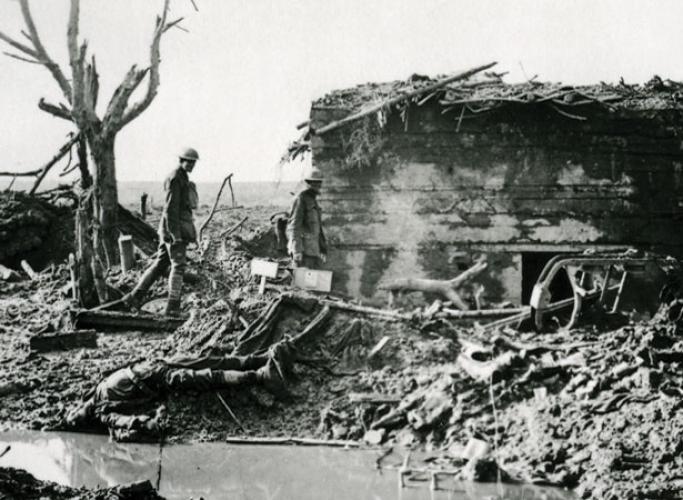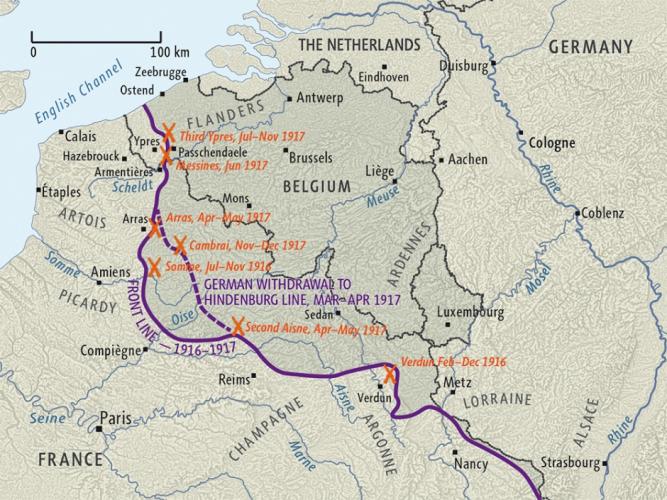128 Passchendaele Grove Upper Hutt, Street Sign 2018
Reason for the name
The Second Battle of Passchendaele, during which 845 New Zealand soldiers died, was the blackest day in New Zealand history. Yet the battle is not well known and most New Zealanders will probably go about their lives with no thought of it.
On the 12th of October 1917, 846 young New Zealanders were killed in the Battle of Passchendaele in Belgium, with many more to die over the coming days from the wounds received on this one day. By the end of the day the total number of casualties, the wounded, the dead and the missing was 2,740. It took two and a half days to clear the battlefield of the dead and injured.
Perhaps because of the horror of these battles, no place in New Zealand can be found that was identified specifically named Passchendale.
At the request of the New Zealand Poppy Places Trust, a very recent new street adjacent to and once part of Trentham Camp the developer agreed to propose to Upper Hutt City Council the honour of this commemoration.
The solitary use of the name was used by New Zealand Railways. AB class locomotive 608 gained the notable distinction of being named Passchendaele in 1918 to commemorate the NZ Railways staff who had been killed in the First World War. The locomotive had its nameplates removed in the 1940s, and they were placed on display in the Christchurch and Dunedin railway stations.
AB 608 Passchendaele was donated by NZ Railways to the New Zealand Railway and Locomotive Society in 1967 as the class leader of the AB class. It was towed to Ferrymead in 1972 and remained there until 1993 when Steam Incorporated of Paekakariki indicated an interest in leasing and restoring 608. It was towed to Wellington as part of a Steam Inc excursion in 1993, and work began to restore the locomotive in 1997.
On the 4th October 2007 (the 90th anniversary of the Battle of Broadseinde) the Rt.Hon Helen Clark ONZ representing the Government of New Zealand was in Ypres where together with the Flemish Government they signed the Ypres Agreement. The agreement committed New Zealand to co-operate in “… increasing broad community recognition … educating younger generations … honouring the war dead … preserving heritage material … and encouraging tourism to commemorative and historical sites in Flanders and New Zealand…” This agreement inspired the 2009 exhibition and the erection of 5,000 white crosses on the parade ground of Fort Takapuna. The Passchendaele Society (Inc.) was formed in March 2011 by a dedicated group of enthusiasts who want to ensure New Zealand’s darkest day is not forgotten.
Author: The Poppy Places Trust
Ever since 1917, Passchendaele has been a byword for the horror of the Great War. In terms of lives lost in a single day, the failed attack on Bellevue Spur on 12 October 1917 was probably the greatest disaster in New Zealand’s history.
Eight days earlier, around 500 New Zealanders died during the capture of Gravenstafel Spur, one of two spurs on the ridge above the village of Passchendaele in Flanders, Belgium. Although this attack was successful, it had a tragic aftermath. The British High Command mistakenly concluded that the number of German casualties meant enemy resistance was faltering and resolved to make another push immediately.
An attack on 9 October by British and Australian troops was to open the way for II ANZAC Corps to capture Passchendaele on the 12th. The plan failed. Without proper preparation and in the face of strong German resistance, the 9 October attack collapsed with heavy casualties.
The New Zealanders nevertheless began their advance at 5.25 a.m. on the 12th. The preliminary artillery barrage had been largely ineffective because thick mud made it almost impossible to bring heavy guns forward, or to stabilise those that were in position. Exposed to raking German machine-gun fire from both the front and the flank, and unable to get through uncut barbed wire, the New Zealanders were pinned down in shell craters. Another push scheduled for 3 p.m. were postponed and then cancelled.
The troops eventually fell back to positions close to their start line. For badly wounded soldiers lying in the mud, the aftermath of the battle was a private hell; many died before rescuers could reach them. The toll was horrendous: 843 New Zealand soldiers were either dead or lying mortally wounded between the front lines.
On 18 October, Canadian troops relieved II ANZAC Corps. In a series of well-prepared but costly attacks in atrocious conditions, they finally occupied the ruins of Passchendaele village on 6 November. The offensive had long since failed in its strategic purpose and the capture of Passchendaele no longer represented any significant gain.
For the New Zealanders, Passchendaele did not end the misery of 1917. In December, at nearby Polderhoek (Poelzelhoek), they suffered another costly setback. By the time they were finally withdrawn from the Ypres salient front line in February 1918, the New Zealanders had suffered more than 18,000 casualties — including around 5000 deaths — and won three Victoria Crosses for bravery. In terms of lives lost, 1917 was the most costly of the NZEF’s three years on the Western Front.




